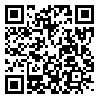Volume 68, Issue 8 (November 2010)
Tehran Univ Med J 2010, 68(8): 473-480 |
Back to browse issues page
1- Department of Internal Medicine, Pulmonary Diseases Branch, Shariati Hospital, Tehran University of Medical Sciences, Tehran, Iran.
2- Department of Internal Medicine, Shariati Hospital, Tehran University of Medical Sciences, Tehran, Iran. ,kh_amiri@razi.tums.ac
2- Department of Internal Medicine, Shariati Hospital, Tehran University of Medical Sciences, Tehran, Iran. ,
Abstract: (13443 Views)
Background: Because bronchial hyper responsiveness (BHR) has been shown to be a risk factor for asthma and lung function decline, interest has focused on diagnosing BHR. The aim of our study was to measure the association between airway caliber relative to lung size expressed as the ratio between forced expiratory flow, mid expiratory phase, divided by forced vital capacity (FEF25-75/FVC) and BHR measured by methacholine challenge test (MCT) to obtain a cutoff for this ratio and positive MCT.
Methods: We carried out a cross- sectional study on general Iranian population in 376 subjects aged 7-73 years who were referred to Shariati hospital in Tehran, Iran in an outpatient setting. There were 190 male (50.5%) and 186 female (49.5%) subjects. They had chronic respiratory symptoms such as cough and dyspnea. The physical examination was normal. Baseline spirometry was normal or equivocal. MCT was done for all subjects over a two year period (2009- 2010). Positive MCT was defined by PC 20≤4mg/ml.
Results: The methacholine challenge test was positive in 191 (50.8%) and negative in 185 (49.2%) patients. The mean of FEF25-75/FVC in positive MCT was 0.86±0.27 Vs. 0.91±0.28 in the negative ones (p=0.070). The sensitivity and specificity of FEF25-75/FVC for prediction of MCT results were 57.1% and 60.2% based on cutoff point of 0.85 in all patients, and 87.5% and 70.7% based on cut off point of 1 in allergic patients, respectively.
Conclusion: The FEF25-75/FVC appears to be a useful predictive ratio in allergic patients but not in general population.
Methods: We carried out a cross- sectional study on general Iranian population in 376 subjects aged 7-73 years who were referred to Shariati hospital in Tehran, Iran in an outpatient setting. There were 190 male (50.5%) and 186 female (49.5%) subjects. They had chronic respiratory symptoms such as cough and dyspnea. The physical examination was normal. Baseline spirometry was normal or equivocal. MCT was done for all subjects over a two year period (2009- 2010). Positive MCT was defined by PC 20≤4mg/ml.
Results: The methacholine challenge test was positive in 191 (50.8%) and negative in 185 (49.2%) patients. The mean of FEF25-75/FVC in positive MCT was 0.86±0.27 Vs. 0.91±0.28 in the negative ones (p=0.070). The sensitivity and specificity of FEF25-75/FVC for prediction of MCT results were 57.1% and 60.2% based on cutoff point of 0.85 in all patients, and 87.5% and 70.7% based on cut off point of 1 in allergic patients, respectively.
Conclusion: The FEF25-75/FVC appears to be a useful predictive ratio in allergic patients but not in general population.
Type of Study: Original Article |
| Rights and permissions | |
 |
This work is licensed under a Creative Commons Attribution-NonCommercial 4.0 International License. |


